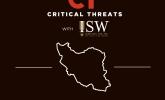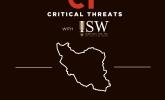Iran Crisis Update, November 12
November 12, 2022 - ISW PressProtest coordinators and organizations have called for countrywide demonstrations from November 15 to 17 to commemorate the three-year anniversary of the Bloody Aban protest wave in November 2019. Citizens took to the streets in around 100 cities in the Bloody Aban protest wave in response to a sudden regime decision to cut fuel subsidies. Estimates of civilians killed by security forces during Bloody Aban range from 304 to 1,500. Some protest organizers have published instructions to “conquer” a main Tehran highway on November 15, blocking the road with cars to restrict security forces’ movement. Persian-language social media accounts have described the ongoing protests as the continuation of the Bloody Aban protest wave in recent weeks, as CTP previously reported. Invoking popular frustrations toward the regime about the Bloody Aban crackdown could reinvigorate this protest movement, which has seen reduced turnout in recent days.








